Other recent blogs



Let's talk
Reach out, we'd love to hear from you!
The advent of microservices opened new vistas of opportunities in software development. By transforming the rules on application scalability—from the brute-force to the fine-grain approach—microservices - led organizations to build a more resilient, reliable, and fault-tolerant IT backbone. Being composed of individual containers integrated seamlessly, microservices applications brought in a bonanza of benefits, including faster turnaround times, improved extensibility, and better uptime.
However, a problem soon stuck its head out: the proliferation of containers. With the steep rise in these stand-alone application containers, organizations faced serious manageability crises and looked for solutions to orchestrate them better. Google was the first to anticipate this challenge, fathom out the potential ways, and develop a robust, efficient solution for managing and deploying microservices containers: Kubernetes.
Kubernetes: The de facto standard for container orchestration
Kubernetes, also known as K8s, is a neo-norm revolutionizing microservices application development. An open-source platform, Kubernetes automates the deployment, scaling, and management of containerized applications and ensures a winning digital value chain poised to scale.
Containers are an effective way to package and distribute applications because they isolate the application and its dependencies from the underlying infrastructure—making it easier to extend and move applications across multiple environments without encountering compatibility issues. Kubernetes provides a mechanism for managing containers in a centralized ecosystem and allows production-grade orchestration.
Kubernetes is evolving full-throttle, transforming microservices architectures as more efficient and streamlined. We explain the five most notable Kubernetes features below:
- Automated Scheduling: Kubernetes has a built-in scheduler that automatically assigns Pods to nodes based on resource requirements and available resources. This allows for the efficient utilization of resources and eliminates the need for manual intervention.
- Self-healing: Kubernetes can automatically detect and replace failed containers, reschedule Pods, and restart crashed containers. This helps ensure high availability and reduces downtime.
- Automated Rollouts and Rollback: Kubernetes provides the ability to easily update the desired state of an application and roll out the changes in a controlled manner. Developers can roll back to a previous version with a single command if any issues arise.
- Horizontal Scaling: Kubernetes enables organizations to scale applications by adding or removing Pods as needed quickly. This can be done manually or automatically based on resource utilization.
- Load balancing: Kubernetes automatically balances incoming network traffic across multiple Pods to ensure an application is highly available and can handle many requests.
The image below shows some more features of Kubernetes.

(Top features of Kubernetes)
Challenges Kubernetes solve that microservices architectures pose

(What microservices challenges does Kubernetes solve?)
Kubernetes trends that are beginning to pick steam in 2023
Microservices are far easier to maintain, test, and deploy than traditional monolithic architectures. The market of microservices architectures is increasing at warp speed, and a few studies suggest exponential growth in the coming years.
Research and Markets predicts a 22.5 percent growth rate for the global microservices market, with a 27.4 percent growth rate for the US market. It further estimates that microservices platform revenue will reach $1.8 million by 2025, growing by over 23.4%.
As microservices become more prevalent, the adoption of Kubernetes will also boost rapidly. Advancements in the field suggest that during 2023, Kubernetes will continue to dominate microservices application development. The promise of the technology to simplify and streamline container management has caught the attention of many, and it is likely to emerge as a real market leader in the niche.
As we look ahead to 2023, we expect the following three Kubernetes trends to explode.
1. Kubernetes emerging as a mitigator of edge computing challenges.
The evolution of Kubernetes is set to unleash a positive impact on the market of edge computing and contribute to its growth. The highly distributed nature of edge environments often puts IT teams in a tight spot while managing numerous codes, sometimes numbering in hundreds or thousands.
Kubernetes, if tailored for edge devices, can bring in a mechanism for automation and process standardization, helping enterprises streamline their data center pipelines at scale and confidently navigate the complexity of edge environments.
E.G.Nadhan, Global Chief Architect—Red Hat, says, ”Kubernetes will see more traction on the peripheral edge devices with the growing availability of optimized variations better suited for them.”
That said, it is imperative to acknowledge that deploying and managing Kubernetes clusters at the edge presents challenges, such as low network bandwidth and limited resources. Overcoming these obstacles necessitates Kubernetes distributions and tools specifically designed for the target edge ecosystems.
2. Growing emphasis on heightened, fail-proof security.
As the use of Kubernetes continues to grow, so does the emphasis on ensuring its security. The adoption of the technology is increasing with a snowball effect, making it a prime target for attackers. Given this, pursuing security as a top-order priority while deploying and managing Kubernetes clusters is now a high-decibel demand.
Organizations are racing to implement robust security measures to protect the host infrastructure, secure network communication between nodes, and safeguard containers and applications. Enterprise IT teams are staying up-to-date with security patches and updates, conducting regular security assessments, and having a comprehensive incident response plan in place.
Many enterprises have realized Kubernetes' potential as a security-focused technology and are transitioning towards adoption, besides the need to secure it. Kubernetes packs a number of built-in features—Namespaces, Role-Based Access Control (RBAC), and Network Policy, to name a few—that can help enterprises secure their infrastructure from looming dangers. The technology also offers third-party solutions that can be integrated into the underlying infrastructure to reinforce security capabilities.
One such solution is the Kubernetes Network Policy, allowing organizations to define and enforce network policies that specify which pods can communicate with each other, limiting the attack surface and reducing the risk of network-based attacks. Another solution is the Pod Security Policy, which helps organizations define and enforce security policies for pods and cover all bases for container-based attacks.
3. Businesses pivoting to service meshes.
The rise in popularity of service meshes is closely tied to the rise of Kubernetes. Organizations adopting Kubernetes also recognize the need for a dedicated infrastructure layer to manage the communication between microservices and to provide security, observability, and control. Service meshes meet this need, and their use has become widespread in organizations adopting Kubernetes.
For the uninitiated, a service mesh is a dedicated infrastructure layer that acts as an intermediary between the services in a microservices architecture, abstracting away the network communication details and enabling developers to focus on writing code that implements business logic. Service meshes also provide a unified platform for robust security, visibility, control, and trust, which can be managed centrally without affecting the individual services themselves.
In 2023, it is expected that the trend toward service meshes will continue to escalate as more organizations adopt Kubernetes and seek to optimize their application delivery processes. Additionally, with the escalating buzz around Kubernetes, there will likely be a corresponding increase in the development of new service mesh technologies and solutions, further expanding their capabilities and making them even more appealing to organizations looking to improve the performance and security of their applications.

The industry’s skepticism about implementing Kubernetes is rife.
While Kubernetes is tipping the scales on modern technology, the industry has widespread doubt regarding its adoption. Experts have cited the following reasons behind their hesitation towards implementing Kubernetes as a standard business practice.
- Complexity: Kubernetes can be complex to learn and operate, which can be a barrier for some organizations.
- Resource requirements: Running Kubernetes clusters can be resource-intensive and require significant hardware and infrastructure resources, which can be cost-prohibitive for some organizations.
- Skills shortage: There is a shortage of skilled professionals with expertise in Kubernetes, a challenge for organizations looking to adopt the technology.
- Vendor lock-In: Some experts are concerned about the potential for vendor lock-in, as organizations may become dependent on specific cloud providers or technology vendors for their Kubernetes deployments.
- Performance: Some experts are skeptical about the performance of Kubernetes in certain use cases, especially when running complex, large-scale applications.
The bottom line
As per the trend forecast, we expect Kubernetes to break the conventional barriers and be a formative force in the world of microservices and container orchestration. The adoption of technology will witness growth, with organizations leveraging its potential in multifarious ways. Additionally, with advancements in the areas of security, scalability, and automation, Kubernetes will become more mature and mark more breakthroughs in the coming years.
Long story short: with its robust ecosystem and growing user base, Kubernetes is poised for dominance in the world of information technology and may open doors to possibilities that only exist in a fairyland.



